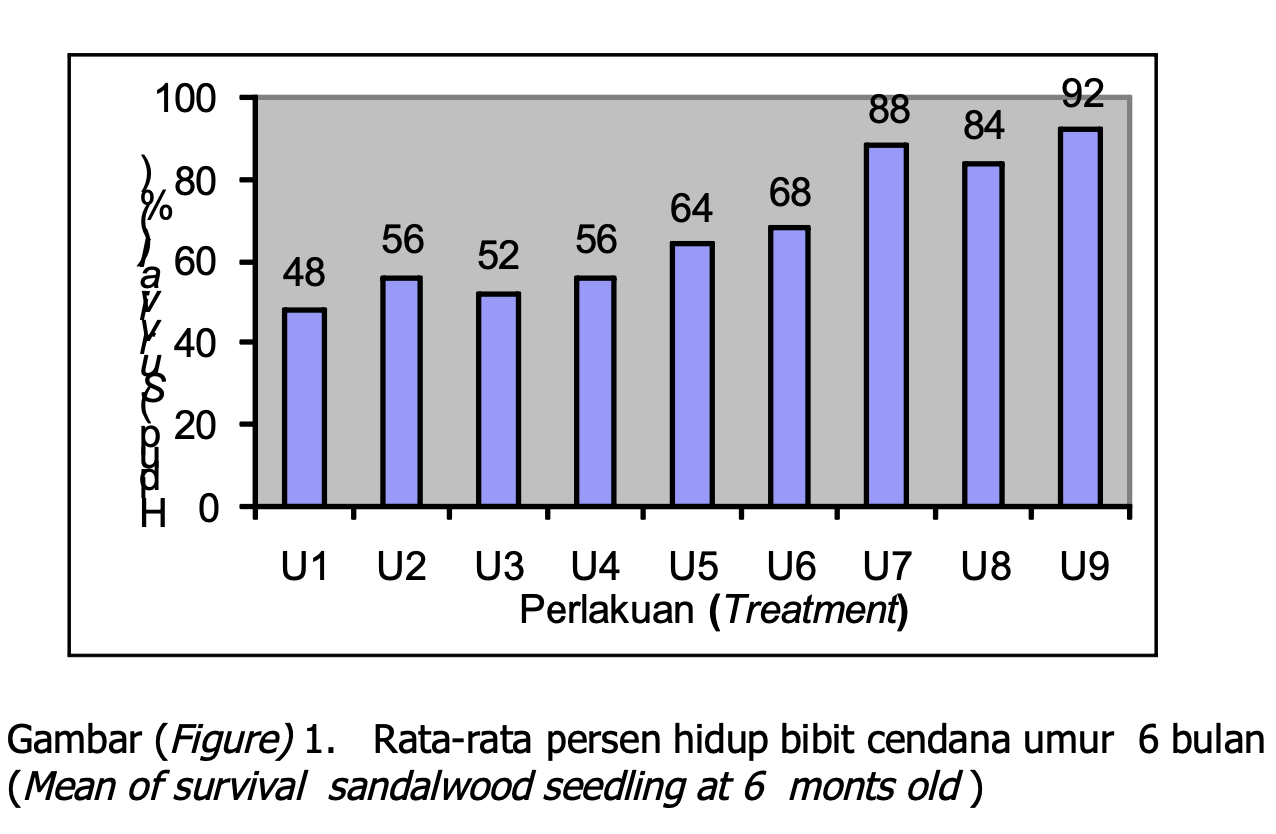Pertumbuhan semai cendana (Santalum album Linn.) pada beberapa ukuran kantung plastik di daerah semiarid

Downloads
Mortality of sandalwood plantings in the semiarid region is high (less than 50 %), due to poor quality. One of seedling of the alternatives to reduce this mortality is using optimal container size. The method is hoped to increase the growth and survival rate of sandalwood seedlings in the field. The objective of this study was to determine the effects of various sizes of seedling container on growth and to recommend the best polybag size for sandalwood nursery. The study was conducted in Complete Randomized Design method using container size of polybag (wide x length as main treatment) i.e.: 7 x 20 cm2, 8 x 20 cm2, 9 x 20 cm, 10 x 21 cm2, 11 x 22 cm2, 12 x 23 cm2, 13 x 23 cm2, 14 x 24 cm2, and 15 x 252 cm. Experiment consisted of 30 replications. The polybag was filled with the potting medium consisting soil, sand, and compost in volume ratio of 4:1:1 and sown with Alternanthera sp. as a primary host plant in all treatment. The results of the experiment proved that application of polybag size (7 cm x20 cm to 15 cm x 25 cm) had significant effects on height, diameter, dry weight total, top root ratio, quality index and survival of sandalwood seedling at six months old. The application of polybag size 15 x 25 cm2 (1080 mL) produced the best growth i.e. height (24.53 cm ), diameter (4.27 mm), dry weight total (1.86 g), top root ratio (0.54), quality index (0.28) and survival (92 %).
Akbar, A., dan Rusmana, 1992. Kontribusi Pengembangan Teknologi Persemaian ATA- 267 di Banjarbaru dalam Rangka Pengembangan Aspek Silvikultur di Indonesia. Prosiding Seminar Nasional, Status Silvikultur di Indonesia Saat Ini. Wanagama 27-29 April 1992. Kerjasama Departemen Kehutanan, Asosiasi Pengusaha Hutan Indonesia, Fakultas Kehutanan Universitas Gadjah Mada. Yogyakarta.
Alkinany, A.I and K.A.I.Aiwas. 1989. Effect of Polythene Bag Capacity and Soil Media on The Growth of Pinus brutia . Mesopotonia Jurnal of Agriculture. 21 (2), 187- 2002.
Annapurna, D., T.S. Rathore, and G. Joshi. 2004. Effect of Container and Size on The Growth and Quality of Seedlings of Indian Sandalwood (Santalum album L). Australian Forestry, 67 (2): 82-87.
Applegate, G. B and J. Chamberlain. 1990. Sandalwood in the Pacific, a State of Knowledge Synthesis and Summary from the April 1990. Symposium on Sandalwood in the Pacific, Honollulu, Department of Agriculture. United States of America.
Balai Penelitian Kehutanan Kupang. 1994. Uji Coba Penanaman Cendana. Kerjasama Balai Penelitian Kehutanan Kupang dan Perum Perhutani Unit II, Wilayah Kupang. Kupang.(Tidak diterbitkan).
Baker, F.S. 1950. Principles of Silviculture. McGraw-Hill Book Co. New York.
Barret, D.R. 1985. Santalum album (Indian Sandalwood) Literature Review, Mulga Research Centre. Western Australian Institute of Technology. Perth.
Barett, D.R. and J.E.D. Fox. 1995. Geographical distribution of Santalaceae and Botanical Characteristics of Species in Genus Santalum. In: Gejerum, L., J.E.D Fox and Y.
Ehrhart .(eds), Sandalwood Seed Nursery and Plantation Technology, FAO, Suva, Fiji. pp.3-23.
Dickson, A., A. L. Leaf and J. F. Hosner. 1960. Quality Appraisal of White Spruce and White Pine Seedling Stock in Nurseries. Forestry Chronicle, 36: 55-60.
Endean, F. And L.W. Carlson.1975. The Effect of Rooting Volume on the Early Growth of Lodgepole Pine Seedlings. Canadian Jurnal of Forest Research . 5, 55-60.
Gardener, F.P., R.B.Peace, and R.L. Mitchell. 1985. Physiology of Crop Plants. The Iowa State University Press. USA.
Hamzah, Z. 1976. Sifat Silfika dan Silvikultur Cendana (Santalum album L.) di Pulau Timor, Laporan No. 227, Lembaga Penelitian Hutan, Bogor.
Hutchine, D.E. 1984. Sandal. In: Barret, D.R. 1985. Santalum album (Indian Sandalwood) Literature Review, Mulga Research Centre. Western Australian Institute of Technology. Perth.
IUCN. 2007. The IUCN Red List of Treated Species. IUCN, Gland, Switzerland.
Misra, .K. and H. R. Jaiswal,. 1993. Effect Size of Polythene Bags and Potting Mixure on the Survival and Growth of Silver Oak (Grevillia robusta Parker) Seedlings. Indian Forester 119:, 940-943.
Pusat Penelitian Tanah dan Agroklimat.1993. Peta Tanah Propinsi Nusa Tenggara Timur. Pusat Penelitian Tanah dan Agroklimat. Badan Penelitian dan Pengembangan Pertanian Bogor.
Santoso, S. 2000. SPSS Mengolah data Statistik Secara Profesional Versi 7,5. P.T. Elex Media Komputindo, Jakarta.
Sharma, I.K. 1996. Different Types of Root Trainer Containers Used in Forest Nurseries and Their Function and Advantages. In Proceeding on Root Trainers Nurseries and Organic Potting Media. Kerala. India. Pp 5-18.
Simpton, G.(1991). Growing Density and Container Volume Affects Nursery and Field Growth of Interior Spruce Seedlings. Nortern Journal of Applies Forestry 8: 160- 165.
Surata, I.K. 1994. Pengaruh Tinggi Bibit Terhadap Keberhasilan Tumbuh Cendana (Santalum album L.). Santalum, 9, 1-9.
Surata, I.K. dan M. Idris 2001. Status Penelitian Cendana (Santalum album L.) di Propinsi Nusa Tenggara Timur. Pusat Penelitian Biologi LIPI. Berita Biologi Edisi Khusus .5 (5) 521-517
Sutherland, S.C. and R.I.Day. 1988. Container Voleme Effects Survival and Growth of White Spruce, Black Spruce and Jack Pine Seedlings: a Literature Review: Nothern Journal of Applied Forestry. 5, 185-189.




